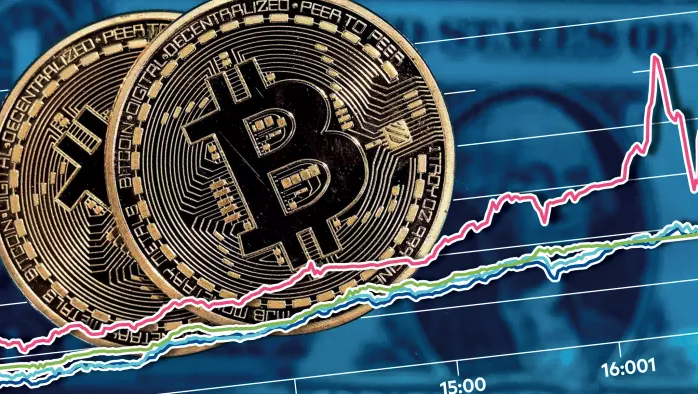Trading Bitcoin
At Systematic Strategies we have developed a brilliant, new investment strategy. We call it buying Bitcoin. It works like this: you take some of your hard-earned fiat and use it to buy Bitcoin. Then, a week or two later, you do the same thing all over again. So far the strategy is up around 400% YTD. Genius.
It’s such a successful strategy that we are tempted to clone it. Buying Litecoin, or Ethereum, spring to mind.
As freshly-minted, bona-fide cryptocurrency entrepreneurs, it is perhaps timely to ponder the roots of this success story and share our discoveries with other, perhaps more rational investors, who may be inclined to treat the whole cryptocurrency malarky as a tulip-Ponzi scheme. First, there is a back-story to this. During  the mid 1990’s I was teaching computational finance at Carnegie Mellon to some very bright students who were, naturally enough, playing the market on the side. This was the time of the internet boom with tech stocks like Amazon, Ebay, Sun Microsystems, et al, leading the charge to ever higher levels in the market. The multiples that some of these stocks were trading at were truly astonishing. I had seen something similar just before the crash in the Japanese market towards the end of the 1980’s, when stocks were trading at three-figure multiples. So by around 1997/98 I was becoming increasingly nervous that the tech boom might be at the point of imminent collapse. I conveyed these sentiments to my students, expressing concern that they should not over-commit themselves to what might turn out to be a bubble. My advice was roundly ignored and for the next couple of years I suffered the almost daily humiliation of watching the market indices reach even higher levels, to the joy of dot com investors. When the crash came many lost most, if not all, of their investment. It was like a funeral in the Hamptons that summer. Teary-eyed students asked me for advice as to what they should do to salvage what was left of their investment nest egg. I didn’t have the stomach for gloating. The only piece of advice I could think to offer them was: “learn”. I hope they did. Because here we are again.
the mid 1990’s I was teaching computational finance at Carnegie Mellon to some very bright students who were, naturally enough, playing the market on the side. This was the time of the internet boom with tech stocks like Amazon, Ebay, Sun Microsystems, et al, leading the charge to ever higher levels in the market. The multiples that some of these stocks were trading at were truly astonishing. I had seen something similar just before the crash in the Japanese market towards the end of the 1980’s, when stocks were trading at three-figure multiples. So by around 1997/98 I was becoming increasingly nervous that the tech boom might be at the point of imminent collapse. I conveyed these sentiments to my students, expressing concern that they should not over-commit themselves to what might turn out to be a bubble. My advice was roundly ignored and for the next couple of years I suffered the almost daily humiliation of watching the market indices reach even higher levels, to the joy of dot com investors. When the crash came many lost most, if not all, of their investment. It was like a funeral in the Hamptons that summer. Teary-eyed students asked me for advice as to what they should do to salvage what was left of their investment nest egg. I didn’t have the stomach for gloating. The only piece of advice I could think to offer them was: “learn”. I hope they did. Because here we are again.
What concerned me back in ’98 was not that I didn’t understand the importance of the new internet paradigm: on the contrary, I was an early adopter of the new technologies. I fully understood the potential benefits that a digital business like Amazon enjoyed versus bricks and mortar rivals. But it’s also the case that I under-estimated the potential of a company like Amazon, in several important ways. For instance, I did not foresee how useful and important customer reviews would become (facilitated by the digital medium); nor did I anticipate Amazon being as successful as it has been in broadening the scope of its services from books (then) to just about everything (now); and I also under-estimated the challenge that the new entrants would pose to traditional rivals, who struggled (and often failed) to adapt their hitherto successful business strategies. In other words, my concern didn’t stem from a lack of appreciation of the potential of the new tech companies, although I certainly under-estimated that potential in some cases. Rather, my thinking was that it had gone too far, too fast and that the blistering pace of the market melt-up would inevitably slow. I was right, but way too early. It is notoriously difficult to get the timing of the bubble-popping right, even if the call is correct.
Chaotic trading marks new surge in bitcoin price
In one wild 20 minute period, the price of bitcoin soared $2,000 per coin to more than $19,000 only to drop to $15,000 on the Coinbase trading venue. – Financial Times, Dec 8th, 2017
So to Bitcoin, which is undergoing a similar melt-up. Again, the rationale for the popularity of cryptocurrencies is not hard to fathom, given all the central bank shenanigans of the last decade and the poor reputation that several major banks have earned as serial manipulators of markets in fiat currency substitutes, like gold, or silver. Once again, it appears to me, the entities whose well established business models are most threatened by the arrival of cryptocurrencies have been slow on the uptake and most, like JP Morgan, for instance, are still in denial. The chief threat from cryptocurrencies lies in their potential to dis-intermediate the banks, by allowing users to transact directly with one another, and also Governments, who stand to lose considerable sums in tax revenue. No doubt they will eventually wake up to the scale of threat that Bitcoin poses and respond accordingly in due course – i.e. expect an avalanche of new regulation and government propaganda seeking to equate ownership of Bitcoin with “money laundering”, whatever that preposterous phrase might actually mean. I am not convinced that the genie can be stuffed back into the bottle so easily.
Given the value and scale of the market that cryptocurrencies are in the process of disrupting, i.e. global banking and taxation, the upside potential is indeed enormous. I fully expect the surge to continue for some time. But we can expect a great deal of volatility and several corrections of 20%, or more, along the way. The first of these might arrive next week, as Bitcoin futures start trading, enabling speculators to initiate short positions against the cryptocurrency. Other adverse events are likely to include increased scrutiny by government agencies like the IRS and market regulators like the SEC, although it remains to be seen how effectively they are able to operate in this sphere.

So, with all that said, here are some thoughts on how to play the market, if you must:
- Check out this useful Beginner’s Guide to Trading Bitcoin
- Invest no more than 10% to 20% of your net worth. Losing this will hurt, but not kill you. Yes, you probably won’t become a Bitcoin billionaire, but neither will you end up in the poor house. Do not, under any circumstances, sell all your assets and plunge in. If you lose your home and the college fund, your wife and kids will never forgive you.
- Wait to see if we get a decent pullback after futures trading starts before you buy (more). If that doesn’t happen, it’s up to you to decide whether you want to wait it out or get aboard the train immediately. There is no right answer. At some point you are going to lose at least 20% of the value of your investment. It could be on day one, or six months from now. There is no way to know.
- I have read a few articles by traders threatening to short the heck out of the futures market as soon as it opens. For some of them this appears to be revenge for having missed a golden opportunity to buy Bitcoin when it was worth a fraction of the price it trades at today. Please don’t do this. It will be like trying to stop a freight train with your hand. You might get lucky, once or twice, but sooner or later you are going to get run over. And it will hurt a lot.
- If you want to trade the short side, or trade the long side more conservatively, consider a pairs trade. By this I mean, for instance, if you do decide to sell Bitcoin futures, consider hedging the position by buying another cryptocurrency like Ethereum or Litecoin. For a detailed description of how to approach this in a more sophisticated way, see these posts:
http://jonathankinlay.com/2017/03/pairs-trading-copulas/
http://jonathankinlay.com/2015/02/developing-statistical-arbitrage-strategies-using-cointegration/
DISCLAIMER
As always, readers are entirely responsible for making their own investment decisions and for any and all consequences arising from them. The author bears no responsibility for any action or decision taken, or not taken, by any investor pursuant to this or other articles and disclaims any responsibility for investment decisions taken by readers of this blog.


